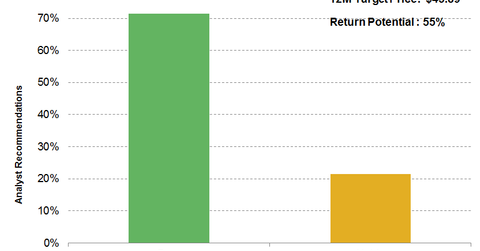Why Most Analysts Still Recommend ‘Buys’ on American Airlines
According to Bloomberg’s consensus, out of the 14 analysts tracking American Airlines (AAL), 71.4% have “buy” recommendations.
Nov. 20 2020, Updated 5:07 p.m. ET

Analysts’ views
Analysts’ recommendations or changes to recommendations on stocks can indicate shifts in long-term trends. In this way, recommendations can significantly impact stock prices. Investors should, however, be aware of possible conflicts of interest.
According to Bloomberg’s consensus, out of the 14 analysts tracking American Airlines (AAL), 71.4% (ten analysts) have “buy” recommendations on AAL, 21.4% (three analysts) have “hold” recommendations, and 7.1% (one analyst) have “sell” recommendations. All analysts have maintained their ratings on AAL.
Target price
However, most analysts have reduced their target prices. American Airlines’ consensus-12-month target price is now $43.89 compared to $50.17 as of the end of 1Q16. The company’s current target price indicates a 55% return potential.
On June 30, 2016. Hunter Keay from Wolfe Research maintained his “outperform” rating on AAL and had the highest target price of $53 on the stock. JPMorgan Chase’s Jamie N. Baker followed, with a $50.5 price target and a continuation of his “outperform” rating.
Darryl Genovesi from UBS and Duane Pfennigwerth from Evercore ISI had the lowest target prices of $38 and $36, respectively, on AAL.
American Airlines makes up 1.8% of the PowerShares Dynamic Market ETF (PWC).
Series overview
AAL is expected to announce its 2Q16 earnings on July 22, 2016.
In the next few articles, we’ll discuss what led to the estimates outlined above, helping investors to judge whether analysts are being optimistic or conservative on the stock. We’ll also help you understand what may be priced in to the stock.
You may want to check out analysts’ estimates for Delta Air Lines (DAL) and United Continental (UAL). We’ll also be covering a 1Q16 preview for AAL’s niche legacy peer Alaska Air Group (ALK).
